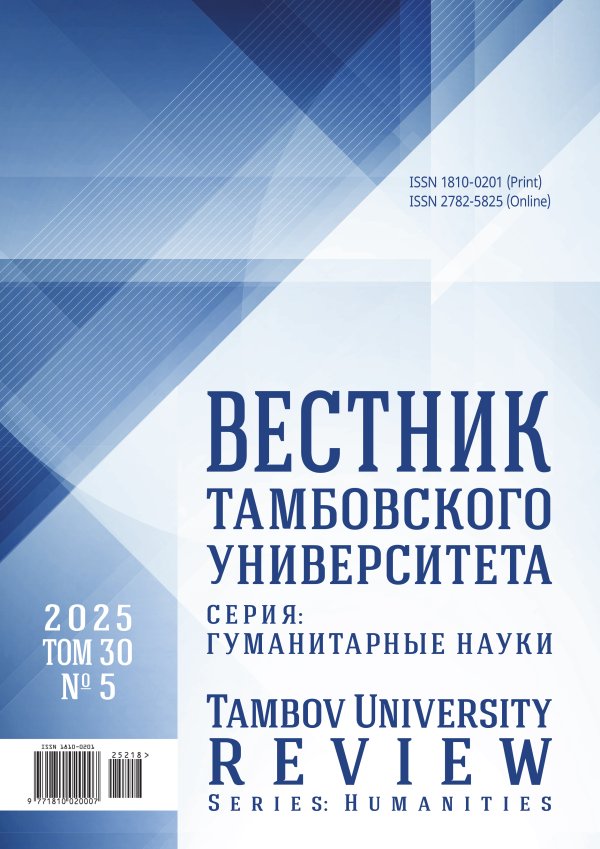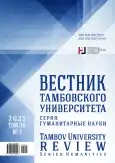Мультилингвальный университет: модели и языковые практики
- Авторы: Чичерина Н.В.1, Полякова М.В.1
-
Учреждения:
- Санкт-Петербургский политехнический университет Петра Великого
- Выпуск: Том 30, № 1 (2025)
- Страницы: 23-34
- Раздел: ТЕОРИЯ И МЕТОДИКА ОБУЧЕНИЯ ИНОСТРАННОМУ ЯЗЫКУ
- URL: https://ogarev-online.ru/1810-0201/article/view/297476
- DOI: https://doi.org/10.20310/1810-0201-2025-30-1-23-34
- ID: 297476
Цитировать
Полный текст
Аннотация
Актуальность. Проведен анализ концепта «мультилингвальный университет» (МЛУ) как образовательной организации нового формата, нацеленной на подготовку конкурентоспособных специалистов для глобального рынка труда в условиях мультилингвизма. Мультилингвальные университеты разрабатывают и внедряют различные модели образовательных программ, отличающиеся различными комбинациями языков преподавания. Цель исследования – рассмотреть понятие мультилингвального университета, его существующих моделей и ключевых характеристик, основанных на положениях институциональной языковой политики.
Материалы и методы. Методы исследования включали анализ теоретической литературы по теме исследования, анализ информации на сайтах мультилингвальных университетов и обобщение практического опыта авторов.
Результаты исследования. Описаны три типа университетских политик как основы возникновения мультилингвальных университетов, выделены их ключевые характеристики. Предложена классификация моделей мультилингвальных университетов с описанием примеров на основе анализа теоретической литературы и информации на сайтах мультилингвальных университетов. Рассмотрены три основных типа образовательных программ: монолингвальная, билингвальная и мультилингвальная – на примере ведущих российских вузов. Необходимость обучения мультинационального контингента студентов в мультилингвальном университете приводит к применению различных языковых практик в процессе обучения, которые представлены в контексте реализации унилингвального или плюрилингвального педагогического дизайна учебных дисциплин.
Выводы. Представленные материалы позволили сделать вывод о том, что мультилингвальный университет является образовательной организацией, процесс обучения в которой направлен на создание стимулирующих условий для получения образования студентами – представителями разных национальностей.
Об авторах
Н. В. Чичерина
Санкт-Петербургский политехнический университет Петра Великого
Email: chicherina_nv@spbstu.ru
ORCID iD: 0000-0002-1040-9120
доктор педагогических наук, профессор, профессор Высшей школы лингвистики и педагогики, директор Гуманитарного института
Россия, 195251, Российская Федерация, г. Санкт-Петербург, ул. Политехническая, 29М. В. Полякова
Санкт-Петербургский политехнический университет Петра Великого
Автор, ответственный за переписку.
Email: marptv@mail.ru
ORCID iD: 0000-0002-6499-680X
старший преподаватель Высшей школы лингвистики и педагогики
Россия, 195251, Российская Федерация, г. Санкт-Петербург, ул. Политехническая, 29Список литературы
- Franceschini R., Veronesi D. Multilingual universities: policies and practices // Innovation and Change in Pro-fessional Education. 2013. Vol. 9. P. 55-72. http://doi.org/10.1007/978-94-007-7043-0_5
- Llurda E., Cots J.M., Armengol L. Views on multilingualism and internationalisation in higher education: admin-istrative staff in the spotlight // Journal of Multilingual and Multicultural Development. 2014. Vol. 35. Issue 4. P. 376-391. http://doi.org/10.1080/01434632.2013.874435
- Moore E. Conceptualising multilingual higher education in policies, pedagogical designs and classroom practices // Language, Culture and Curriculum. 2016. Vol. 29. Issue 1. P. 22-39. https://doi.org/10.1080/07908318.2016.1132652
- Risager K. Language hierarchies at the international university // International Journal of the Sociology of Lan-guage. 2012. № 216. P. 111-130. https://doi.org/10.1515/ijsl-2012-0042
- Зникина Л.С., Седых Д.В. Педагогические условия актуализации процесса обучения студентов в поли-лингвальной образовательной среде вуза // Профессиональное образование в России и за рубежом. 2018. № 4 (32). С. 173-177. https://elibrary.ru/yuvixr
- Левченко Н.В. Поликультурная образовательная среда и ее педагогический потенциал // Вестник Калуж-ского университета. 2016. № 1. С. 66-69. https://elibrary.ru/vskfpz
- Чичерина Н.В. Особенности разработки образовательных программ высшей школы в контексте мульти-лингвизма // Шатиловские чтения. Перспективы развития парадигмы иноязычного образования. Санкт-Петербург, 2021. С. 23-33. https://elibrary.ru/frqvyl
- Fortanet-Gomez I. CLIL in Higher Education towards a Multilingual Language Policy. Bristol: Multilingual Matters Publ., 2013. 312 p.
- Langner M., Imbach R. The University of Freiburg: a model for a bilingual university // Higher Education in Europe. 2000. Vol. 25. Issue 4. P. 461-468. https://doi.org/10.1080/03797720120037796
- Гузикова М.О., Ессяк Е.С. Модель полиязычной образовательной среды копенгагенского университета // Университетское управление: практика и анализ. 2018. Т. 22. № 4 (116). С. 68-82. https://doi.org/10.15826/umpa.2018.04.041, https://elibrary.ru/ypfzln
- Madiba M. Towards multilingual higher education in South Africa: the University of Cape Town’s experience // Language Learning Journal. 2010. Vol. 38. Issue 3. P. 327-346. https://doi.org/10.1080/09571736.2010.511776
- Doiz A., Lasagabaster D., Sierra J.M. Language friction and multilingual policies in higher education: the stakeholders' view // Journal of Multilingual and Multicultural Development. 2014. Vol. 35. Issue 4. P. 345-360. https://doi.org/10.1080/01434632.2013.874433
- Chicherina N.V., Strelkova S.Y. Translanguaging in English language teaching: Perceptions of teachers and stu-dents // Education Sciences. 2023. № 13 (1). Р. 86. https://doi.org/10.3390/educsci13010086, https://elibrary.ru/mhfhda
- Baker C. Foundations of Bilingual Education and Bilingualism. Clevedon: Multilingual Matters, 2001. 484 p.
- Lewis G., Jones B., Baker C. Translanguaging: origins and development from school to street and beyond // Educational Research and Evaluation. 2012. Vol. 18. Issue 7. P. 641-654. https://doi.org/10.1080/13803611.2012.718488
- García O., Li Wei. Translanguaging. Language, Bilingualism and Education. Basingstoke: Palgrave Macmillan, 2014. 324 p.
- Creese A., Blackledge A. Translanguaging in the bilingual classroom: a pedagogy for learning and teaching? // The Modern Language Journal. 2010. Vol. 94. Issue 1. P. 103-115. https://doi.org/10.1111/j.1540-4781.2009.00986.x
- Jones B. Translanguaging in bilingual schools in Wales // Journal of Language, Identity & Education. 2017. Vol. 16. Issue 4. P. 199-215. https://doi.org/10.1080/15348458.2017.1328282
- Hornberger N., Holly L. Translanguaging in today’s classrooms: a biliteracy lens // Theory into Practice. 2012. Vol. 51. Issue 4. P. 239-247. http://doi.org/10.2307/23362829
Дополнительные файлы










